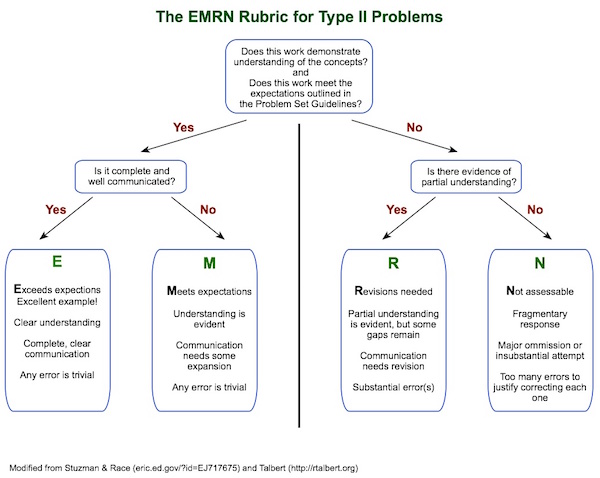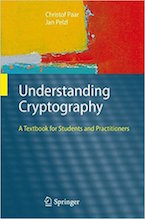Guidelines for Solutions to Problem Sets - Math 202 Cryptography - Fall 2016
One of the central goals of the course is that you improve your ability to communicate mathematics clearly, both in writing and verbally. Learning to write precise and complete mathematical arguments is a challenging endeavor and may be somewhat different from your experiences in previous math courses. However, the process will not only aid your mathematical development but can also greatly improve your clarity of thought in other disciplines as well.
The Problem Sets consist of two types of problems. Type I problems are primarily computational and more straightforward, whereas the Type II problems are usually more conceptual in nature.
You will have a Problem Set due most weeks, so you should definitely start early and take advantage of my office hours. Check the Tentative Syllabus for the exact due dates.
Evaluation of Problem Sets
You should always have a target audience in mind whenever you write. Here is a good rule of thumb to follow for your Problem Sets:
Write your solutions so that you could hand them to a student who took Cryptography two years ago and she would be persuaded that your solution is correct and that your conclusions are believable.
Type I problems will be graded Pass / No Pass. A problem earns a P if there are only minor computational errors and the explanation is convincing. The solution must consist of more than just mathematical computations unless the context of the problem clearly indicates that computation alone is sufficient. For example, including a summary of what you are about to do at the very beginning of a solution is a simple and effective way of orienting and guiding the reader through a sequence of computations. A problem earns an NP if there are substantial errors or the explanation is lacking. In this course, it is definitely true that P ≠ NP.
The Type II problems will be assigned a grade of E, M, R, or N.
Exceeds expectations
Meets expectations
Revisions needed
Not assessable
See the section below for details on the EMRN rubric.
Revising problems
On the first two Problem Sets, you may submit a revision to any Type II problem for which you receive an M, R, or N, and the grade you receive on the revised problem will replace the original grade.
On subsequent Problem Sets, you may revise any Type II problem for which you received an R or N, and the highest score you may receive is a M. In other words, after the second Problem Set, you can only earn an E on a problem for the initial submission.
Note that in order to submit a revision to a problem, you must have made an effort on the problem in the first place. In other words, you may not submit a revision to a problem you left blank on your initial submission.
Revisions are due at 3:00 pm one week after the Problem Set is returned. You must turn in your original Problem Set with your revisions. On the first page of your revisions, clearly mark the problems you are revising.
Format for your write-ups
I have high expectations for the organization and presentation of your Problem Sets. I am not being unnecessarily annoying about this. Learning to carefully organize your thoughts and clearly communicate them is one of the most important skills you will learn in college.
Organize your Problem Sets with all Type I problems grouped together, in order, at the beginning, followed by your Type II problems, also in order. Please begin your first Type II problem on a new sheet of paper. Clearly label each problem with the chapter and exercise number. -
Your writing must be clear and legible. I strongly suggest you write up your solutions using pencil so that you can more easily correct mistakes, but if you do use a pen, there should be no scratch-outs.
Do not turn in paper torn from a spiral notebook with ragged edges. Your solutions should be well-written, using complete sentences to justify your results where necessary. I firmly believe that one of the best ways to build your understanding of mathematics is to explore the ideas with other students. Therefore, I encourage you to discuss the Problem Sets with other students enrolled in Cryptography this fall, but you must turn in separate papers that represents your own work. If you do work with someone else on an assignment or a specific problem, you must indicate that on your Problem Set. All of this may be summarized by what I have come to identify as the transitive property of happiness in grading: The neater and better organized your assignment is, the happier I am while grading it, and therefore, the happier you will be when it is returned.
More details on the EMRN rubric
The following chart describes the basic rubric that will be used for evaluating your Type II problems.

Click for larger version
There are three types of errors that frequently occur:
A computational error occurs when a mathematical computation is carried out incorrectly, either by hand or by computer. For example, solving x3 =8 to obtain x=3 is a computational error. A conceptual error occurs when one of the concepts from the course is applied incorrectly or the solution is not complete. An error in communication occurs when the solution is not well-organized or fully justified for the target audience. In particular,
The solution should not omit any parts that would not be obvious to the target audience that contribute to the solution. If you are in doubt about what counts as "obvious" relative to the target audience, please ask me! The solution should be concise and not include any information that is not relevant to the solution.
The general rule is: Grades of E or M are awarded only if there are no significant errors of any of the above kinds, and only if the number of minor errors of the above kinds is minimal. That is, a small number of minor errors can be tolerated as long as they do not cast doubt on your understanding of the concept, or cause the work to fail to meet the expectations of the assignment, or cause the work to be incomplete or poorly-communicated. However, large numbers of minor errors, or a single instance of a major error, will result in the work being marked R or N.
A grade of E is awarded only if there are just a few trivial errors that don't really affect the solution (things like a few misspelled words, a minor sign error in a calculation that is later corrected, etc.)
Please note that it is possible to earn an E or M grade on an assignment even if you have a few errors in it. That is, "Passing" does not mean "perfect". A Passing grade (E or M) means that your work has demonstrated understanding of the concept, has met the expectations for the assignment, and it is complete and well-communicated.
* Many of the ideas, and some of the language used, are due to Robert Talbert at Grand Valley State University.
|

|